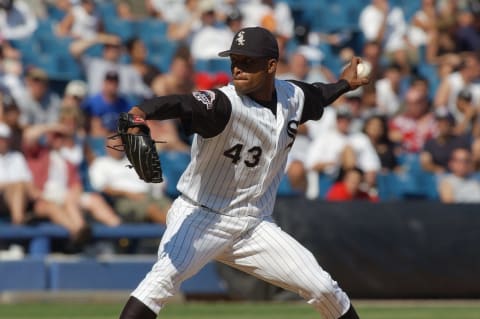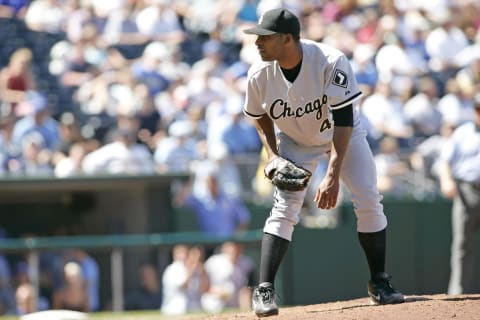White Sox: The Mount Rushmore of middle relief


No piece of the puzzle to create a Mount Rushmore for each position in the history of the Chicago White Sox proved more problematic than the role of the middle reliever or setup man.
Specific roles for relief pitchers didn’t evolve until the late 1980s and early 1990s, prior to that relievers were mostly pitchers who didn’t have either the stamina or the stuff to go through the lineup multiple times and were thus sent to the bullpen as failed starters.
Middle relievers in particular were a hard thing to define because for more than a century of baseball, the pitcher expected to get himself out of trouble in the middle of a game was the starter, i.e., the guy who got himself into that mess in the first place.
Related Story. Mount Rushmore of White Sox left fielders. light
But now we’ve reached a point in the evolution of baseball that the middle reliever may be the pitcher that most often is brought into high-leverage situations — runners already on base that the starter put there and a need to work out of trouble or at least limit the amount of damage to what has already been done.
The modern setup man works the seventh or eighth inning, often coming in at the beginning of the frame with the bases empty. The same goes for the closer, a role covered in our Mount Rushmore series here.
The late onset of this role is reflected by the 24 pitchers meeting the criteria for consideration: At least 150 relief appearances with fewer than 50 saves. Many of them served as the closer (or as it was called in its early days, the fireman) for at least part of their time with the White Sox, but only one of them — Sarge Connally — pitched for the team before 1950.
Conversely, half of the qualifiers pitched all or part of their White Sox careers in the 21st century.
Some of the anomalies found:
- The group’s lone Hall of Famer did not earn a spot on Mount Rushmore. Rich Gossage spent five seasons in Chicago — three as a reliever/spot starter, one as an outstanding closer and one as a not-so-outstanding starter.
- Two of the earliest qualifiers, Turk Lown and Gerry Staley, sort of shared responsibilities at the end of games. The duo would have tied for the American League lead in saves in the White Sox pennant-winning campaign of 1959, each saving 15.
- Gossage was one of four in the group to spend at least a season in a defined closer’s role, along with Eddie Fisher, Bob Howry and Bob Locker.
All that said, here are the qualifiers:
- Juan Agosto (1981-86)
- Sarge Connally (1921, 1923-29)
- Neal Cotts (2003-06)
- Jesse Crain (2011-13)
- Fritz Dorish (1951-55)
- Eddie Fisher (1962-66, 1972-73)
- Jace Fry (2017-20)
- Rich Gossage (1972-76)
- Bob Howry (1998-2002)
- Dan Jennings (2015-17)
- Nate Jones (2012-19)
- Matt Karchner (1995-98)
- Scott Linebrink (2008-10)
- Bob Locker (1965-69)
- Turk Lown (1958-62)
- Damaso Marte (2002-05)
- Donn Pall (1988-93)
- Jake Petricka (2013-17)
- Cliff Politte (2004-06)
- Scott Radinsky (1990-93, 1995)
- Bill Simas (1995-2000)
- Jerry Staley (1956-61)
- Matt Thornton (2006-13)
- Kelly Wunsch (2000-04)
Mount Rushmore of White Sox middle relief: Jesse Crain
Jesse Crain made seven starts in his professional baseball career, all in the minor leagues and all on rehabilitation assignments where he was just going to pitch an inning and hand the ball over to the scheduled starter.
No, Crain came into pro ball as a reliever and he remained one for the duration.
He came to the Chicago White Sox in December 2010 as a free agent from the Minnesota Twins and spent a little more than 2½ seasons on the South Side. After being named to his lone career All-Star Game appearance in 2013, Crain went on the shelf with a shoulder strain and the Tampa Bay Rays picked him up near the non-waiver trade deadline for future considerations.
In December 2013, Crain signed with the Houston Astros, but didn’t pitch for them as his shoulder did not respond following biceps tenodesis surgery in the fall of 2013. He also battled rotator cuff inflammation.
He returned to the White Sox as a free agent in January 2015 and did make six rehab appearances with the club’s team in the Rookie-level Arizona League, but gave up five runs, four earned, in 5.1 innings. That was the end of his comeback attempts, but he refused to actually say the word “retirement.”
In three seasons with the White Sox, he saved only one game, but he was used primarily in the seventh and eighth innings in high-leverage situations. Of his 156 appearances, his average leverage index was 1.655. The scale attempts to measure the pressure of game situations with 1.000 being the average.
He had 53 holds for Chicago, allowing 30 percent (26-of-88) inherited runners to score. He had a 2.10 ERA and 1.167 WHIP in 150 innings, with per-nine-inning rates of 10.7 strikeouts and 3.9 walks.
Crain was a second-round pick by the Twins out of the University of Houston in 2002 and made his big-league debut in August 2004.

Mount Rushmore of White Sox middle relief: Damaso Marte
Damaso Marte’s career with the Chicago White Sox began as part of minor three-player trade — the White Sox sent minor-leaguer Matt Guerrier to the Pittsburgh Pirates and got Marte along with minor-leaguer Ruddy Yan.
Marte would go on to pitch four solid seasons in Chicago, getting five outs and the win in the White Sox’ 7-5 14-inning win in Game 3 of the 2005 World Series over the Houston Astros.
Marte’s first two years with the White Sox saw him in a setup role with occasional opportunities to close; he saved 21 games in 2002-03. In 2004, he was converted into a role that no longer exists — the lefty-one-out-guy, or LOOGY. That role vanished when MLB made a rule change before the 2020 season requiring pitchers to face a minimum of three batters.
Indeed, Marte was very good against left-handed hitters in his career, allowing a .195 average and .575 OPS. But right-handed batters only hit .242 with a .726 OPS, so he could get hitters out.
In four seasons for the White Sox, Marte posted a 2.78 ERA and 1.212 WHIP in 279 appearances over 259 innings, saving 31 games and registering 71 holds while pitching in tough spots — his average leverage index was 1.536. He struck out 9.8 batters and walked 4.1 per nine innings.
Marte, a native of the Dominican Republic, originally signed with the Seattle Mariners in October 1992, and pitched five games for the M’s in 1999. He refused an outright assignment to the minors in October 2000 and signed with the New York Yankees. They traded him to the Pirates, where he returned to the majors in June 2001.
He was traded back to Pittsburgh by the White Sox in December 2005 for Rob Mackowiak and later pitched with the Yankees, missing the 2011 season — save for one disastrous rehab appearance in the Rookie-level Gulf Coast League — after shoulder surgery in the fall of 2010. His career ended when he went unsigned after his contract expired in the fall of 2011.

Mount Rushmore of White Sox middle relief: Gerry Staley
Like many pitchers of his era that wound up in the bullpen, Gerry Staley went there when he could no longer be an effective starting pitcher. But Staley embraced the new role and extended his career in grand style as a top reliever for the Chicago White Sox.
The White Sox claimed the veteran right-hander off waivers from the New York Yankees in May 1956 and Staley worked out of the pen and as a spot starter. Pressed into the rotation in September because of a backlog of doubleheaders, Staley did throw three straight complete games wins between Sept. 9-23.
He never made another start in the majors, settling in as a valued fireman for the White Sox. He led the league with 67 appearances, 37 games finished and tied for the lead with 15 saves in 1959 as Chicago won its first pennant in 40 years. He was chosen for both All-Star games in 1960 at age 39 and three times worked more than 100 innings out of the pen for the White Sox.
In June 1961, the 40-year-old Staley was traded to the Kansas City Athletics in an eight-player deal.
In parts of six seasons with the White Sox, Staley had a 2.61 ERA and 1.148 WHIP in 270 games and 541.2 innings, with 38 saves and an average leverage index of 1.190. Typical for the era, Staley pitched to contact, with per-nine-inning rates of 3.5 strikeouts and 2.1 walks.
He began his career with Class-C Boise in the Pioneer League in 1941 and after two seasons there was selected by the St. Louis Cardinals in November 1942 minor-league draft. After three years in the Army as a medic during World War II, Staley got called up for the first time in April 1947.
Staley was an All-Star as a starter for St. Louis in 1952 and 1953 before he was traded to the Cincinnati Reds in December 1954. In September 1955, the Yankees claimed him off waivers from Cincinnati. He finished his career with the Detroit Tigers in 1961 before he was released after the season. He spent three years as pitching coach for the Triple-A Portland Beavers after his career.
He died at age 87 in January 2008.

Mount Rushmore of White Sox middle relief: Matt Thornton
The final face for the Mount Rushmore of Chicago White Sox middle relievers is left-hander Matt Thornton, who came out of the Chicago bullpen for 7½ seasons. Like the other White Sox relievers named here, Thornton was not originally a member of the organization.
In March 2006, the White Sox acquired Thornton from the Seattle Mariners for a former No. 1 prospect in the organization that just didn’t quite pan out, outfielder Joe Borchard.
He was a mainstay in the bullpen until July 2013, when he was traded to the Boston Red Sox for minor-leaguer Brandon Jacobs.
Thornton was used in big spots often, with an average leverage index of 1.441 over his 512 appearances for the White Sox, and he was credited with 146 holds and 23 saves. He was never the closer, but he was honored with an All-Star selection in 2010, when he had a career-high eight saves in 61 appearances.
In his Chicago career, Thornton had a 3.28 ERA and 1.196 WHIP in 463.1 innings, with per-nine-inning rates of 9.4 strikeouts and 3.0 walks. He posted a sub-1.000 WHIP for the 2008 club that won the AL Central and pitched 3.1 scoreless innings in three appearances of the White Sox four-game loss to the Tampa Bay Rays in the ALDS.
The Mariners took Thornton 22nd overall in the first round of the 1998 draft from Grand Valley State University in Michigan and he came through their organization as a starter before making his debut with Seattle in 2004. He made one start with the Mariners as a rookie, but that was the last time he took the ball to begin a game.
Next. Every No. 1 prospect for the White Sox this century. dark
Thornton later played with the New York Yankees, Washington Nationals and San Diego Padres, retiring after he was released by San Diego in August 2016.